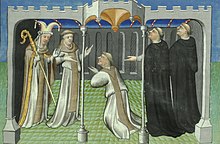
Back III Yabalaxa Azerbaijani Yahballaha III Spanish یهبالله سوم Persian Yahballaha III French Yab-Alaha III Italian Mar Yaballaha III NB Jabalaha III Polish Ябалаха III Russian 雅巴拉哈三世 Chinese
Yahballaha III | |
|---|---|
| Patriarch of the Church of the East | |
 A 15th-century miniature depicting Riccoldo da Monte di Croce in the audience before Yahballaha III | |
| Church | Church of the East |
| See | Seleucia-Ctesiphon |
| Elected | November 1281 |
| Installed | 21 November 1281 |
| Term ended | 13 November 1317 |
| Predecessor | Denha I |
| Successor | Timothy II |
| Other post(s) | Bishop of Northern China and Ongud |
| Orders | |
| Consecration | 1279 by Denha I |
| Personal details | |
| Born | Markos c. 1245 |
| Died | 13 November 1317 Maragheh, Ilkhanate |
| Nationality | Ongud |
| Denomination | Church of the East |
| Residence | Maragheh, Ilkhanate |
Yahballaha III (c. 1245–13 November 1317), known in earlier years as Rabban Marcos (or Markos) was Patriarch of the East from 1281 to 1317. As patriarch, Yahballaha headed the Church of the East during the severe persecutions under the reign of khans Ghazan and his successor Öljaitü. He acknowledged the primacy of the Pope and tried to form a church union, which was rejected by the Nestorian bishops of the Church of the East.[1]
A native of Koshang, Marcos travelled with Rabban Bar Sauma, an ascetic Nestorian monk from Mongol-controlled China to Jerusalem. However, they were prevented from reaching their final destination due to the war between the Mongols and Mamluks. Patriarch Denha I of the Church of the East recalled them and consecrated Markos as the bishop of Katay and Ong, Mar Yahballaha. However, both opted to remain in monasteries in Mosul.
Yahballaha's election as the new patriarch of the Church of the East was approved by Abaqa Khan for political reasons and consecrated in 1281 as Yahballaha III. In 1282, Abaqa Khan's brother Tekuder, a convert to Islam, succeeded the throne. The Old Mongol party of Buddhists and Nestorian Christians opposed Tekuder, who started persecuting the Church of the East for siding with the Old Mongol party. Yahballaha was imprisoned, but his life was saved by Tekuder's Christian mother Qutui Khatun. In 1284, Abaqa Khan's son Arghun became the khan, and he held both Yahballaha and Bar Sauma in high esteem. Arghun sought an alliance with Christian Europe against the Muslims in Syria and Egypt and, advised by Yahballaha, sent Bar Sauma for the first East Asian diplomatic mission to Europe in history. After the fall of Acre to Muslims in 1291, the popular opinion in Ilkhanate started to incline towards Islam. The relations between the Church of the East and the khan remained well during the rule of Gaykhatu, Arghun's successor. However, with Arghun's son Ghazan ascendance to the throne, Muslims gained dominance. Ghazan started the persecution of Christians, and Yahballaha was again imprisoned. He was ransomed by Hethum II of Armenia.
In 1289, Yahballaha allowed the Dominican friar Riccoldo da Monte di Croce to preach among the Nestorians and renounced their heterodoxies. He sought a church union with the Catholic Church in Rome. He started negotiations in 1302 by writing to Pope Boniface VIII and Pope Benedict XI in 1304, professing the Catholic faith in the latter letter and acknowledging the pope's primacy over all of Christendom. However, the union was rejected by the Nestorian bishops. In 1304, Öljaitü succeeded Ghazan and renewed the persecutions against Christians, which Yahballaha unsuccessfully tried to end. Yahballaha died in Maragheh in 1317.
- ^ Filoni 2017, p. 32.
© MMXXIII Rich X Search. We shall prevail. All rights reserved. Rich X Search